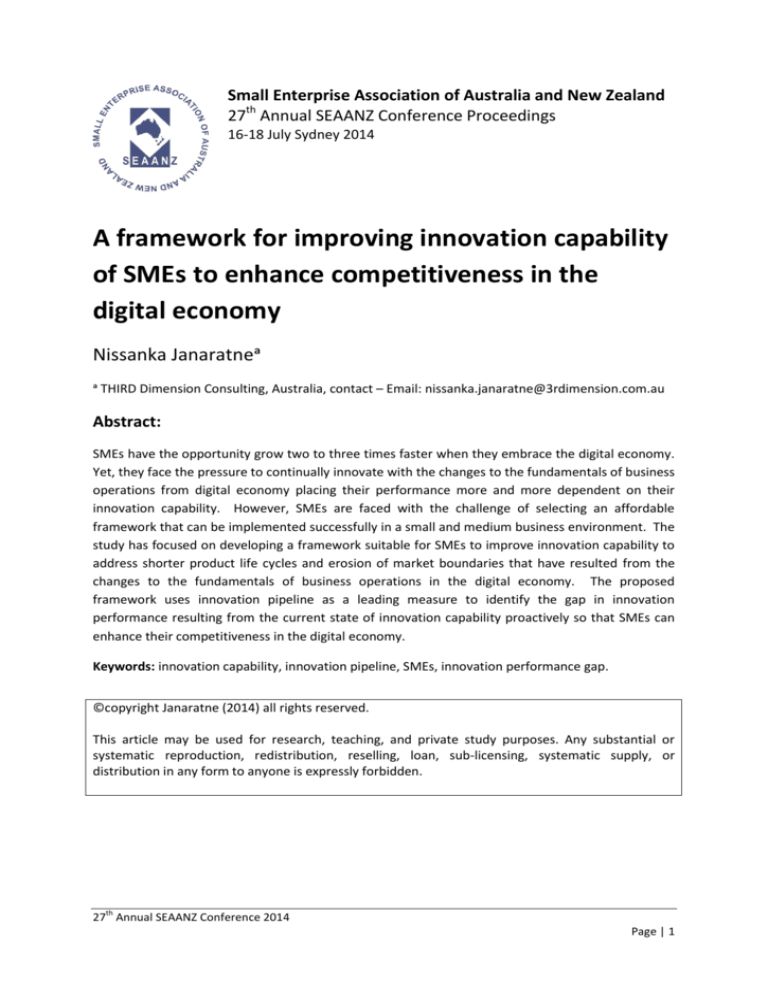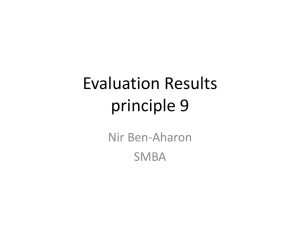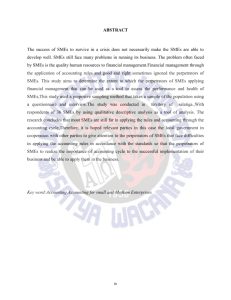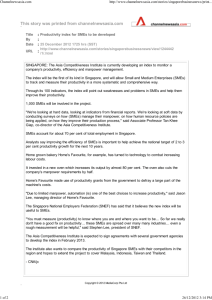
Small Enterprise Association of Australia and New Zealand
27th Annual SEAANZ Conference Proceedings
16-18 July Sydney 2014
A framework for improving innovation capability
of SMEs to enhance competitiveness in the
digital economy
Nissanka Janaratneᵃ
ᵃ THIRD Dimension Consulting, Australia, contact – Email: nissanka.janaratne@3rdimension.com.au
Abstract:
SMEs have the opportunity grow two to three times faster when they embrace the digital economy.
Yet, they face the pressure to continually innovate with the changes to the fundamentals of business
operations from digital economy placing their performance more and more dependent on their
innovation capability. However, SMEs are faced with the challenge of selecting an affordable
framework that can be implemented successfully in a small and medium business environment. The
study has focused on developing a framework suitable for SMEs to improve innovation capability to
address shorter product life cycles and erosion of market boundaries that have resulted from the
changes to the fundamentals of business operations in the digital economy. The proposed
framework uses innovation pipeline as a leading measure to identify the gap in innovation
performance resulting from the current state of innovation capability proactively so that SMEs can
enhance their competitiveness in the digital economy.
Keywords: innovation capability, innovation pipeline, SMEs, innovation performance gap.
©copyright Janaratne (2014) all rights reserved.
This article may be used for research, teaching, and private study purposes. Any substantial or
systematic reproduction, redistribution, reselling, loan, sub-licensing, systematic supply, or
distribution in any form to anyone is expressly forbidden.
th
27 Annual SEAANZ Conference 2014
Page | 1
INTRODUCTION
Small and medium businesses contribute about 55 per cent of economic output of Australian
businesses and employ 70 per cent of Australia’s labour force. There is no single definition for an
Australian small and medium business, which is most commonly defined by the number of
employees or by annual turnover or, a combination of the two. Australian Bureau of Statistics
defines a small business as an actively trading business with 0-19 employees and 20-199 employees
as a medium-sized business.
According to Australian Bureau of Statistics, digital economy in Australia grew 25% in 2011-12 with
Australian businesses earning 237 billion dollars in income from the sale of goods and services
online. A dynamic and strong digital economy is critical for the economic growth in NSW and
Australia. National digital economy strategy defines digital economy as “the global network of
economic and social activities that are enabled by information and communication technologies
such as the Internet, mobile and sensor networks”.
Digital economy is defined as social and economic activities that are enabled by digital technologies
comprising of Internet, mobile technology platforms and ubiquitous sensors. Digital technologies
are rapidly transforming both business practices and societies driving productivity, wealth, and
profits to record highs (Brynjolfsson and McAfee, 2014). However, organisations and skills advance
slowly creating an ever-increasing gap. This will result in industries being challenged, disrupted and
transformed.
Many studies highlight that SMEs are the growth and job creation engines in Australia as well as in
other regions of the world. A study conducted by European Commission in 2012 has revealed that
European SMEs grow two to three times faster when they embrace the digital economy. Yet, MYOB
Business Monitor 2013 Report has found at least one third of small to medium businesses reduce
their performance potential by overlooking significant opportunities offered by the digital economy.
An organisation’s performance is more and more dependent on its innovation capability (Alasoini et
al, 2007). Managing innovation capability is one of the basic elements of an innovative organisation.
An organisation has to develop its innovation capability to become innovative. Sunila and Ukko
(2012) posit that organisations devoting themselves to develop their innovation capability have
better prospects to succeed in the future. However, many SMEs still face the challenge of finding an
affordable framework that can improve their innovation capability (Nada et al, 2012). This study
aims to address this gap with the proposed framework that can improve innovation capability of
SMEs
LITERATURE REVIEW
Innovation is one of the most important resources for SMEs to improve and sustain their level of
competitiveness in the market (Keizer, 2002). According to an empirical study of SME innovation
within the Australian wine industry increased innovative activities of South Australian SMEs have led
to increased competitive advantage and exports (Aylward and Glynn, 2006). Enhancing product or
service quality, lowering costs or restructuring are no longer sufficient to stay ahead in today’s hyper
competition. Innovation pressures apply to large companies as well as SMEs (Vrakking and
Cozijnsen, 1997).
th
27 Annual SEAANZ Conference 2014
Page | 2
Companies need to develop their innovation capability to become innovative. Managing innovation
capability is one of the basic elements of an innovative organisation. According to Saunila and Ukko
(2012) in today’s challenging environment, development of innovation capability is vital for
organisations to be competitive and have better prospects to succeed in the future. Innovation
capability is defined as an organisation’s potential to generate innovative outputs (Neely et al, 2001)
or in more detail as its ability to continuously transform knowledge and ideas into new products,
processes and systems for the benefit of the firm and its stakeholders (Lawson and Samson, 2001).
Measurement of innovation capability is critical to understand the current state and the future need
for its development. However, measurement of innovation capability is difficult due to its intangible
nature and as a result one has to resort to proxies that capture observable qualities that reflect them
(Albaladejo and Romijn, 2000). Evolution of innovation metrics can be categorized to four
generations (Gamal, 2011). The first generation of metrics focused on inputs while the second
generation complemented input indicators by accounting for the intermediate outputs. The current
practices of measurement consist of third generation metrics focusing on benchmarking of
innovation capability based on surveys together with emerging fourth generation metrics based on
knowledge indicators.
Innovation capability has traditionally been measured via questionnaires or other subjective
assessment models (Saunila and Ukko, 2012). Best measures of innovation capability relate to the
outputs that result from the utilization of a firm’s innovation capabilities although they are hard to
quantify. Current literature provides a number of frameworks/models for measuring innovation
capability that provide different perspectives of focus (Gamal, 2011 and Nada et al, 2012). Among
them, diamond model (Tidd, Bessant and Pavitt, 2005), Kelly’s survey instrument (Kelly and Littman,
2006), and Hansen and Birkinshaw’s (2007) innovation value chain represent the foundation upon
which innovation audit tools such as 1-innoCERT, Inno-Biz and IMP3rove have been developed.
The link between innovation capability and firm performance is significant in the presence of
performance measurement (Saunila, Pekkola and Ukko, 2014). Therefore, the research study based
on current literature of innovation capability has focused on using performance measurement as a
tool for improving the performance of SMEs through innovation capability. A study of Australian and
Thai SMEs on the effectiveness of innovation measurements found that those SMEs that used a
balanced approach were more likely to perceive benefits of implemented innovations than those
that used only a financial approach to measurement (Sawang, Unsworth and Sorbello, 2007).
However, review of literature on metrics that are used to measure innovation performance highlight
that they can only measure past performance and that many SMEs also did not actually use many of
the metrics.
Innovation is becoming more and more distributed in the digital economy with the notions of value
and industry being shaken up more often by firms from outside the industry or small start-ups who
focus more on consumer needs rather than industry boundaries (Strategy Dynamics Global SA,
2013). Continuing rapid advances in digital technologies are reducing the product life cycles
increasing pressure on organisations to manage them effectively to operate and compete
successfully in the digital economy. As a result, market leaders generate a major portion of their
revenue from products and services introduced within recent years (Sopheon, 2010).
th
27 Annual SEAANZ Conference 2014
Page | 3
As firms enter the digital world, businesses will need to digitalize business processes and invent new
digital business models to seize transient business moments. These transient business moments
demand a fast response from organisations to develop new capabilities to address these new
opportunities. Organisations are no longer able to sustain their competitive advantage with
improving their innovation capabilities using historic innovation performance data. Firms require
adopting a culture of relentless and rapid business experimentation in order to survive and compete
in the digital economy (Vernon, 2013), which highlights the increasing need for leading innovation
performance indicators.
According to a Gartner January 2014 press release, organisations that use predictive business
performance metrics will increase their profitability by 20 per cent. A number of studies have been
devoted to examining the value and relevance of nonfinancial “leading indicators” motivated by the
increasing importance of these indicators for growth (Gu, 2005). Leading metrics used in the
industry include ideas generated, ideation sessions held, and pipeline while lagging indicators are
new products and percentage of sales due to new products.
CONCEPTUAL FRAMEWORK AND METHODOLOGY
Based on current literature on improving innovation capability, the study focused on metrics or
methods to measure its current condition and formulate a strategy for improvement (Galvez et al,
2013). Measures of innovation capability used in this study are based on outputs of innovative
activities that have been found to be the best measures from previous research (Neely et al, 2005,
Saunila and Ukko, 2012). However, despite research progress on innovation capability in the recent
years with the inclusion of outputs as measures of innovation capability (Saunila and Ukko, 2012) or
with the use of multivariate metrics (Galvez et al, 2013) firms still have to rely on historic data to
improve innovation capability.
The study has found the use of historic data to be a gap in current literature on improving innovation
capability to be competitive in the digital economy and proposes a framework to improve innovation
capability using innovation outputs as a leading indicator. Output measures from current literature
usually measure the results of successful innovations (Tura et al, 2008) that comprise mainly of
finance based and non-finance based measures. Finance-based metrics such as return on investment
and non-finance-based metrics such as customer retention, productivity or employee development
have been found from review of literature (Sawang, Unsworth and Sorbello, 2007). In order to avoid
the need to wait until innovations introduced in the market to show results to measure them the
study proposes to use the “innovation pipeline” as an output measure of innovative activities of a
company.
In recent years, the need for an innovation pipeline for building a systemic innovation capability has
much received attention from researchers and consulting firms (McDonald, 2014, Hunt, 2013, Kelly,
2012, ProQuest, 2011). The definition of innovation pipeline used for this study is a structured flow
of innovative projects that introduce new innovations (Jost, Lorenz and Mischke, 2005). The method
of measuring the level of innovativeness of the projects in the pipeline is based on the degree of
novelty (originality) embodied in the innovations and the technological complexity or the extent to
which the development of these innovations required advanced technological expertise (Albaladejo
and Romijn, 2000 and Capaldo et al (2003).
th
27 Annual SEAANZ Conference 2014
Page | 4
The level of innovativeness of project pipeline is measured based on the inherent degree of
“uncertainty” of such projects (Jalonen and Lehtonen, 2011 and Janaratne, 2013) with levels of
technological uncertainty and project novelty as given in Figure 1 and 2 (Shenhar and Dvir, 2007).
The level of innovativeness of individual projects in the innovation pipeline can be measured using
the proposed weights as shown in Figure 3 based on non-linear characteristic of technological
complexity and market adoption (Asthana, 1995 and Kaplan, 2007).
Figure 1: Measurement of Novelty of Innovation Pipeline
Figure 2: Measurement of Technology Complexity of Innovation Pipeline
The average level of innovativeness of projects in the pipeline is used to determine the planned
“innovation zone” of the firm as shown in Figure 3. If an SME targets for an above industry growth
in performance, the organisation can proactively assess the “innovation performance gap” which is
the gap between the target innovation zone and the planned innovation zone. The innovation
performance gap is conceptualized based on the link between innovation and organisational
th
27 Annual SEAANZ Conference 2014
Page | 5
performance from literature (Saunila and Ukko, 2012, Albaladejo and Romijn, 2000). Although
innovation zone is used more frequently in literature to denote a physical zone with specific
geographic boarders (Mikroglou and Khan, 2009), the study proposes to use it in an organisational
perspective related to the level of market impact and technology progress (Kallbach, 2012).
Figure 3: Innovation Zones
Super
Tech
High
Innovative
High
Innovative
High
Innovative
High
Tech
Medium
Innovative
High
Innovative
High
Innovative
Mid
Tech
Low
Innovative
Medium
Innovative
High
Innovative
Low
Tech
Technology Complexity
Weight
Low
Innovative
Low
Innovative
Medium
Innovative
Platform
Breakthrough
Derivative
Market Novelty
Technology
Novelty
1
Low tech
Derivative
4
Medium tech Platform
9
High tech
16
Super
tech
high
Innovation Zone
Low innovative zone
Medium
zone
Breakthrough
Score
Less than 5
innovative 5 to 10
High innovative zone
More than 10
In conceptualisation of innovation capability, the study uses the definition of innovation capability as
the potential of an organisation to generate innovative outputs (Neely et al, 2001). Factors that
form the innovation potential of an organisation can be divided into five categories as follows based
on earlier literature on innovation capability (Saunila and Ukko, 2012, Tidd, Bessant and Pavitt, 2005)
and on innovation audit tools such as the IMP3rove assessment targeted for SMEs:
1.
2.
3.
4.
5.
Strategy on innovation and related leadership and decision making processes
Organisational structure, culture and communication for innovation
Innovation process and life cycle management
Collaboration, external links and enabling factors
Individual creativity, learning and innovation results
Based on above definition of innovation capability, the study proposes to measure the “innovation
capability gap” defined as the gap between the target innovation capability uplift required to
generate the target innovation pipeline and the planned innovation capability uplift that would
generate the planned innovation pipeline. Based on the outcome of innovation performance gap
and innovation capability gap using the proposed framework as shown in Figure 4 an organisation
th
27 Annual SEAANZ Conference 2014
Page | 6
can proactively select areas to improve its innovation capability that would result in the target
growth in performance to sustain competitiveness in the digital economy.
Figure 4: Framework for Improving Innovation Capability
Target
Current
Innovation
Capability
Assessment
Planned Capability
Uplift
Areas of
Improvement
Innovation
Capability Gap
Planned Innovation
Pipeline
Firm
Performance
Innovation
Performance Gap
Innovation Zone
FINDINGS
The study has been able to extend the current literature on frameworks to improve innovation
capability that rely on historic measures of innovation performance (Saunila and Ukko, 2012, Nada
et al, 2012, Galvez et al (2013) with the use of innovation pipeline as a leading indicator. The
method used in the proposed framework to measure innovation pipeline as a leading indicator
contributes to the current literature on how such leading indicators can be measured to improve
innovation capability of SMEs to address the shorter product life cycles and erosion of market
boundaries in the digital economy.
The use of innovation zones as a way to categorize a firm’s planned innovation performance
provides with an easy to understand method for SMEs to take proactive action to improve their
innovation capabilities. The study has been able to align the categorization approach with the
predominant types of innovations (Kallbach, 2012) such as incremental, breakthrough, disruptive
and game changing innovation types. The study found the use of innovation maturity classification
(Esterhuizen, Schutte and Du Toit, 2012) to categorize innovation zones did not meet the purpose of
the study, as firms with higher levels of maturity will continue to develop incremental innovations.
The study combined the current literature from project management discipline (Shenhar and Dvir,
2007) to measure innovation pipeline from innovation management discipline based on
“uncertainty” (Jalonen and Lehtonen, 2011 and Janaratne, 2013) common to both disciplines for
developing new products and managing innovative projects. The method of measurement has been
a key finding of the study that made possible the utilization of innovation pipeline to improve
innovation capability proactively in SMEs to sustain competitiveness in the digital economy.
DISCUSSION
Firms increasingly operate in fast changing and competitive environments with the rapid advances in
digital technologies. Yet, firms are slow to develop dynamic capabilities (Teece, 2007) to sustain
their competitive advantage with business strategies validated through “fail fast, learn fast”
th
27 Annual SEAANZ Conference 2014
Page | 7
experiments that are more critical in the digital economy (Vernon, 2013). Study could not find
evidence from literature to support that firms are convinced that they can leverage innovation
capability to build dynamic capabilities. Author is of the view that this is due to dominant use of
historic measures in current frameworks to improve innovation capability of firms.
Innovation gap is defined as the gap between innovation expectations and performance. Most
executives believe innovation is very important for the future success of their organisation while
they are not satisfied with the innovation results their organisations are achieving. Although reasons
such as lack of common understanding on what innovation is, how it happens, what prevents it or
lack of innovative leaders are found in literature (Weiss and Legrand, 2011), author is of the view
that lack of ways to assess innovation gap such as provided by the proposed framework can act as
inhibitors to take timely action.
Implications for policy and practice
The proposed framework to improve innovation capability supports the policy focus of the “National
Innovation Framework for Australia” produced by Business Council of Australia in conjunction with
the Society for Knowledge Economics (2006) on improving the innovation capabilities. The
framework also calls for more specific innovation capabilities at the organisational level to influence
growth and competitiveness in the digital economy as Australia is behind its peers in digital
innovations (PwC Study, 2014).
Literature contains several empirical studies on innovation and performance of Australian SMEs
while some of them contain comparisons with SMEs from other countries. However, there is a lack
of research studies in literature for frameworks focusing on performance measurement aspect
(Saunila and Ukko, 2012) as well as affordable frameworks for SMEs (Nada et al, 2012). The study
contributes to the practice on frameworks focusing on both of these aspects with the proposed
framework.
Limitations and future research directions
Best way of measuring innovation capability from current literature is to use a multi-criteria
approach (Galvez et al, 2013). The proposed framework measures innovation capability based on
outputs of innovative activities (Neely et al, 2005, Saunila and Ukko, 2012) using innovation pipeline
measured with technological uncertainty and project novelty. Use of two criteria is a limitation of
the proposed framework based on current literature. On the other hand, the study has used a
leading innovation measure to improve the innovation capability of firms that can be used in future
research studies as current literature has a gap with the use of such innovation performance
measures.
SMEs that use a balanced approach to measurement of innovation capability rather than those that
use only financial approach are more likely to perceive benefits of implemented innovations
(Sawang, Unsworth and Sorbello, 2007). Approach of the measures used in the study is limited to
non-financial measures. Author acknowledges that the study should use a balanced approach to
measurement of innovation capability with further improvements of the proposed framework while
limiting them to the measures that are easily measured in a small and medium business
environment.
th
27 Annual SEAANZ Conference 2014
Page | 8
Although the proposed framework has been developed based on literature review of frameworks as
a conceptual framework to improve innovation capability its validity is not limited due to lack of
empirical studies with SMEs as the framework has been developed based on research literature that
include empirical studies.. Author is of the view that the future direction of research on innovation
should focus more on helping SMEs to improve their competitiveness in the digital economy as
Australia is behind its global peers when it comes to digital innovation. .
CONCLUSIONS
The focus of the study was to develop a framework to improve innovation capability of SMEs which
do not usually have much available financial wealth and required planning infrastructure in order to
be competitive in the digital economy (Nada et al, 2012). The need for the study was based on the
previous research findings on the difficulties faced by SMEs to benefit from fast moving digital
opportunities due their current digital maturity level against digital leaders who outperform their
peers in every industry (Westerman et al, 2012). .
The study found that the best way to approach the problem was to use the link between innovation
capability and firm performance, which is significant in the presence of performance measurement
(Saunila, Pekkola and Ukko, 2014). However, the study took the path of using a leading indicator
such as innovation pipeline to improve innovation capability proactively to seize opportunities from
rapid advances in digital technologies building a culture of relentless and rapid business
experimentation.
The use of innovation zones to categorize potential innovation performance zones addresses the
flexibility much required to improve innovation capability in a proactive manner in the digital
economy. As a result, SMEs can use the assessment of the innovation performance gap proactively
to gauge whether the company would achieve a high organic growth in performance based on the
planned innovation capability uplift.
The company can then use the innovation capability gap from the proposed framework to determine
the areas that are required to be uplifted to generate the innovation pipeline that can achieve the
intended growth in performance. As a result, the proposed framework addresses another gap in
measuring the innovation projects in terms of their impact on the overall goals of an organisation
(Nada et al, 2012). This enables SMEs to respond to opportunities presented by rapid advances in
digital technologies found in the digital economy.
REFERENCES
Albaladejo, M. and Romijn, H. (2000), “Determinants of Innovation Capability in small UK firms: an
empirical analysis”. Working Paper 40, QEH Working Paper Series.
Alyward, D. and Glynn, J. (2006), “SME innovation within the Australian wine industry: A cluster
analysis”, Journal of the SMAANZ 14(1): 42-54.
Asthana, P. (1995), “Jumping the Technology S-Curve”, IEEE Spectrum 32(6): 49-55
Australian Communications and Media Authority (2014), “Report 1 - Australian SMEs in the Digital
Economy”, Communications Report 2012-13 Series.
th
27 Annual SEAANZ Conference 2014
Page | 9
Brynjolfsson, E. and McAfee, A. (2014), “The Second Machine Age: Work, Progress, and Prosperity in
a Time of Brilliant Technologies”, W.W. Norton & Co., NY, USA
Capaldo, G., Iandoli, L., Rffa, M., Zollo G. (2003), “The evaluation of innovation capabilities in small
software firms: a methodological approach”, Small Business Economics 21(4): 343-354
Esterhuizen, D., Schutte, C. and Du Toit, A. (2012), ‘A knowledge management framework to grow
innovation capability maturity’, SA Journal of Information Management 14(1): 495-504, viewed
10 April, 2014, http://dx.doi.org/10.4102/sajim.v14i1.495
European Commission (2012), “Integrating Automotive: Connecting SMEs to the digital supply
chain”, European Union, viewed 15 March 2014, http://www.odette.org /repository//autogration_eBusiness_Guide.pdf
Galvez, D., Camargo, M., Rodriguez, J., Morel, L. (2103), “PII- Potential innovation index: a tool to
benchmark innovation capabilities in international context”, Journal of Technology
Management & Innovation 8(4): 36-45
Gamal, D. (2011), “How to measure organization innovativeness?: an overview of innovation
measurement frameworks, innovation audit/management tools”, viewed 15 Nov 2013,
http://www.tiec.gov.eg/backend/Reports/MeasuringOrganizationInnovativeness.pdf
Gu, F. (2005), “Innovation, future earnings, and market efficiency”, Journal of Accounting, Auditing &
Finance 20(4): 385-418
Gartner Inc. (2014), “Gartner says organizations using predictive business performance metrics will
increase their profitability 20 percent by 2017”, January16, 2014 press release, viewed 10
March 2014, www.gartner.com/newsroom/id/2650815
Hunt, M. (2013) “Using the innovation pipeline to drive growth & address failure”, Innovation
Excellence Blog, web log post, 4 September 2013, viewed 15 March 2014,
http://www.innovationexcellence.com/blog/2013/09/04/using-the-innovation-pipeline-todrive-growth-address-failure/
Jalonen, H., Lehtonen A. (2011), “Uncertainty in the innovation process”, Proceedings of European
conference on innovation and entrepreneurship, Aberdeen, Scotland, UK, viewed 15 March
2014, http://www.virtuproject.fi/wp-content/uploads/2011/02/
ECIE2011_Jalonen_Lehtonen_VIRTU_April_2011.pdf
Janaratne, N. (2013), “Effectiveness of project governance of PRINCE2 project management
methodology for innovative IT projects”, Proceedings of Australian Institute of Project
Management conference, Perth, Australia
Jost, A, Lorenz, T., Mischke, G. (2005), “Modelling the innovation pipeline”, Proceedings of the
International Conference 2005, System Dynamics Society, viewed 15 Mar 2014,
http://www.systemdynamics.org/conferences/2005/proceed/papers/JOST157.pdf
Kallbach, J. (2012), “Clarifying innovation: four zones of innovation”, viewed 10 April 2014,
http://experiencinginformation.wordpress.com/2012/06/03/
Kaplan, S. (2007), “Innovation lifecycles: leveraging market, technology, and organizational S-curves
to drive breakthrough growth”, viewed 15 March 2014, http://www.innovationpoint.com/Innovation_Lifecycles.pdf
th
27 Annual SEAANZ Conference 2014
Page | 10
Keizer, J., Dijkstra, L., Halman, J. (2002), “Explaining innovative efforts of SMEs: An exploratory
survey among SMEs in the mechanical and electrical engineering sector in the Netherlands”,
Journal of Technovation 22: 1-13.
Kelly, B. (2012), “Innovation pipeline challenges and risks”, Innovation Excellence Blog, web log post,
25 Jun 2012, viewed 15 Mar 2014, http://www.innovationexcellence.
com/blog/2012/06/25/infographic-innovation-pipeline-challenges-and-risks/
Lawson, B. and Samson, D. (2001), “Developing innovation capability in organisations: a dynamic
capabilities approach”, International Journal of Innovation Management 5(3): 377–400.
McDonald, J. (2014), “Lessons for managing your innovation pipeline” Executive Insights Blog, web
log post, 16 March 2014, viewed 10 April 2014, https://emba.mit.edu/theexperience/executive-insights-blog/lessons-for-managing-your-innovation-pipeline/
Mikroglou, E., Khan, T. H. (2009), “The role of innovation zones in regional development”, Masters
thesis, Jonkoping University, viewed 10 April 2014, http://www.divaportal.org/smash/get/diva2:223011/FULLTEXT01
MYOB (2013), Business Monitor Report: September 2013, viewed 10 April 2014,
http://myob.com.au/myob/backing-aussie-business/myob-business-monitor-1258090877325
Nada, N., Ghanem, M., Mesbah, S., Turkyilmaz, A. (2012), “Innovation and knowledge management
practice in Turkish SMEs”, Journal of Knowledge Management, Economics and Information
Technology 2(1): 248-265
Neely, A. Filippini, R., Forza, C., Vinelli, A. and Hii, J. (2001), “A framework for analysing business
performance, firm innovation and related contextual factors: perceptions of managers and olicy
makers in two European regions”, Integrated Manufacturing Systems 12(2): 114-124.
ProQuest (2011), “Centres of excellence: creating an innovation pipeline”, ProQuest Blog, web log
post, 5 November 2011, viewed 15 March 2014, http://support.dialog.com/
enewsletters/eyeoninnovation/201105/
PwC Study (2014), “Expanding Australia’s Economy: How digital can drive the change”, viewed 10
June 2014, http://www.pwc.com.au/consulting/assets/publications/ Expanding-AustraliasEconomy-Apr14.pdf
Saunila, M. and Ukko, J. (2012), “A conceptual framework for the measurement of innovation
capability and its effects”, Baltic Journal of Management 7(4): 355-375
Saunila, M., Pekkola, S., Ukko, J. (2014), “The relationship between innovation capability and
performance: The moderating effect of measurement” International Journal of Productivity and
Performance Management 63(2): 234-249
Sawang, S., Unsworth, K., Sorbello, T. (2007), “An exploratory study of innovation effectiveness
measurement in Australian and Thai SMEs”, International Journal of Organizational Behaviour
12(1): 110-125
Shenhar, A.J., Dvir, D. (2007), “Reinventing project management: the diamond approach to
successful growth”, Harvard Business Press, MA
Sopheon plc (2010), “Innovation Governance: Aligning Strategy, Ideation and Execution for Better
Business Results”, viewed 10 June 2014, http://www.sopheon.com
Teece, D. (2007), “Explicating dynamic capabilities: the nature and micro foundations of
(sustainable) enterprise performance”, Strategic Management Journal 28(13): 1319-50
th
27 Annual SEAANZ Conference 2014
Page | 11
Tura, T., Harmaakorpi, V., Pekkola, S. (2008), “Breaking inside the black box: towards a dynamic
evaluation framework of regional innovative capability”, Science and Public Policy 35(10): 733744
Vernon, M. (2012), “Implications of The Rate of Organizational Learning on Value Capture in the
Digital Economy”, Proceedings of the 31st International Conference of the System Dynamics
Society, USA
Vrakking, W.J., and Cozijnsen, A.J. (1997), “Monitoring the quality of innovation processes and
innovation successes’’, The Innovation Challenge, John Wiley & Sons: 25-49
Weiss, D.S., Legrand, C.P. (2011), “Innovative Intelligence: The Art and Practice of Leading
Sustainable Innovation in Your Organization”, John Wiley & Sons Canada, Ltd.
Westerman, G. et al (2012), “The Digital Advantage: How digital leaders outperform their peers in
every industry”, viewed 10 June 2014, http://www.capgemini.com
th
27 Annual SEAANZ Conference 2014
Page | 12










